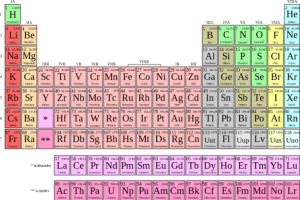Playlist
Show Playlist
Hide Playlist
Ph Scale – How Atoms Come Together to Form a Molecule
-
Slides 03 AtomsFormsMolecules CellBiology.pdf
-
Reference List Molecular and Cell Biology.pdf
-
Download Lecture Overview
00:00 So we can hardly wrap up speaking about chemistry without addressing acids, bases and buffers. 00:06 The pH scale is at the base of that. We could have the pOH scale but in biology we generally stick to the pH scale which is a measure of hydrogen ion concentration in a solution. 00:19 pH is a measure of the -log of hydrogen ion concentration in mols in a solution. 00:29 So each level we change in pH, say from 7 to 6 is actually a 10 times change, or an order of 10 in magnitude more or less of hydrogen ions in the solution. So, each step up is actually a very large step. If we look at the pH scale, you're probably quite familiar with the fact that lemons are quite acidic and household bleach or shampoos are quite basic. But all this has to do with is greater or lesser hydrogen ion concentration. Something that is acidic has more hydrogen ions in solution. And something that is more basic has more hydroxide ions or less hydrogen ions in solution. 01:17 So water is the perfect neutral molecule because it has an equal amount of hydroxide and hydrogen in solution. Just as water molecules are constantly reassociating with each other because of the slight positive and negative charge, hydrogen and hydroxide ions are also separating, not quite as much. 01:42 But that lends itself to being completely neutral because there is an equal number of hydrogen ions as there are hydroxide ions in the solution. And hence, water has a neutral pH of 7. 01:54 Again, in biology we stick with the pH scale rather than the pOH scale. And so we have a measure of pH 1 through 14. 1 being very acidic and 14 being very basic with water right in the middle at 7.
About the Lecture
The lecture Ph Scale – How Atoms Come Together to Form a Molecule by Georgina Cornwall, PhD is from the course Introduction to Cell Biology.
Included Quiz Questions
How is the pH scale defined?
- An exponential scale represented by –log [H+]
- The measure of [OH-]
- The measure of pressure in a closed vessel
- The measure of atmospheric humidity
- A ratio that gives the measure of free ions in a gas
Why does pure water exist at a pH of 7?
- The concentrations of H+ and OH- ions are equal when a water molecule dissociates.
- More H+ ions than OH- ions are produced when a water molecule dissociates.
- More OH- ions than H+ ions are produced when a water molecule dissociates.
- The intermolecular forces are not strong for a water molecule to exist as separate ions.
- Water molecules tend to stick together due to strong intramolecular cohesive forces.
The pH in the small and large intestines is approximately 7.5 and 5.5, respectively. What would happen to the H⁺ ion concentration as a substance travels from the small intestine to the large intestine?
- 100 fold increase
- 100 fold decrease
- 2 fold increase
- 2 fold decrease
- 10 fold increase
Customer reviews
5,0 of 5 stars
| 5 Stars |
|
1 |
| 4 Stars |
|
0 |
| 3 Stars |
|
0 |
| 2 Stars |
|
0 |
| 1 Star |
|
0 |
Very good use of examples connecting to every day life.




